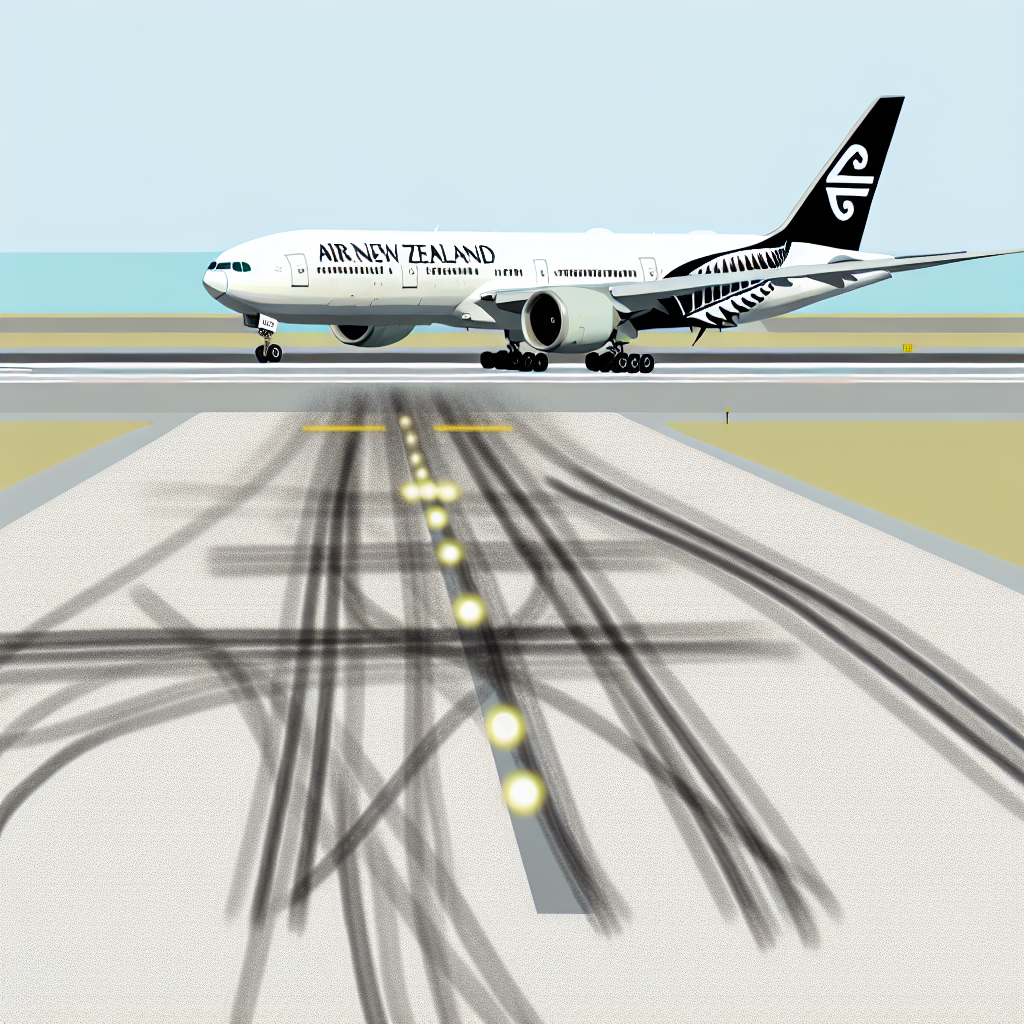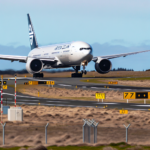AUCKLAND- The New Zealand Transport Accident Investigation Commission has determined that pilot error was the cause of an incident involving an Air New Zealand (NZ) Boeing 777-300ER, which veered off the runway and struck multiple runway edge lights while landing at Auckland International Airport (AKL).
The investigation revealed that the captain did not adequately adjust for the aircraft’s control system response after disengaging the autopilot too late during the approach phase.

The Air New Zealand (NZ) twinjet took off from Melbourne (MEL) and was approaching Auckland (AKL) on January 27, 2023, with 271 passengers and 16 crew members aboard.
During the approach, the aircraft executed an ILS/DME approach to runway 05R under challenging weather conditions, including heavy rain and variable crosswind patterns.
These crosswind conditions fluctuated in both direction and strength, adding complexity to the landing process.
The Boeing 777’s autopilot was engaged in runway-alignment mode throughout the approach, which helped to automatically adjust for the gusty winds.
Beginning at 500 feet above ground level, the system utilized left aileron and right rudder inputs to counteract the left crosswind and keep the aircraft aligned with the runway’s centerline.
These automatic adjustments allowed the aircraft to remain on course while maintaining the target approach speed.
Timing Error
Air New Zealand’s standard protocols recommend that pilots disengage the autopilot between 300 and 600 feet above ground level, providing them enough time to gain manual control before starting the landing flare maneuver.
However, the captain deviated from this guideline and kept the autopilot engaged until the aircraft was just 67 feet above ground level.
By the time the autopilot was finally disengaged, the aircraft had already crossed the runway threshold.
The sequence of events shows a tight timeline of critical actions following the autopilot’s deactivation.
The crew decreased the thrust to idle just one second after turning off the autopilot.
The landing flare began three seconds later, allowing minimal time for the pilot to effectively establish manual control over the aircraft.
Pilot Input Faults
The Transport Accident Investigation Commission highlighted a crucial aspect of system behavior that contributed to the incident. When the autopilot disengages, the flight controls are automatically returned to neutral positions.
Investigators stressed that pilots must actively maintain the control inputs set by the autopilot to continue on the established flight path. Data from the flight recorder indicated that the pilot failed to sustain the left aileron input that had been compensating for the crosswind.
Loss of Control
The inability to maintain the correct control inputs led to the Boeing 777 rolling 3.69 degrees to the right and drifting away from the runway’s centerline. The changing crosswind conditions continued to develop during this critical timeframe, with wind speed lessening and the direction adjusting further to the left.
The investigation found that the pilot could not effectively manage the combination of the aircraft’s rightward tilt and the fluctuating crosswinds within the brief time available.
Damage Assessment
Just nine seconds after the autopilot was turned off, the aircraft touched down and promptly veered off the runway onto the sealed shoulder area.
The Boeing 777 struck six runway edge lights before the crew was able to regain control and steer the aircraft back to the runway centerline.
The investigation concluded that this runway excursion was “virtually certain” given the actions taken, regardless of the runway’s surface conditions. While the runway was wet from rain, no standing water was present that could have contributed to this incident.
Safety Outcome and Aircraft Damage
Fortunately, all 271 passengers and 16 crew members were unharmed during the incident. However, the Boeing 777 incurred significant damage to its landing gear systems.
Five of the six right main landing gear tires were found damaged, with the rear inboard tire completely deflated.
Further damage was inflicted on the right brake assembly and wiring harness, necessitating extensive maintenance before the aircraft could resume service.
Stay connected with us for more updates. Follow us on our social platforms for the latest news.
Join our Telegram Group for the Latest Aviation Updates, and follow us on Google News
Based on an article from aviationa2z.com: https://aviationa2z.com/index.php/2025/05/31/air-new-zealand-777-veered-off-the-runway-amid-pilot-error/?utm_source=rss&utm_medium=rss&utm_campaign=air-new-zealand-777-veered-off-the-runway-amid-pilot-error



